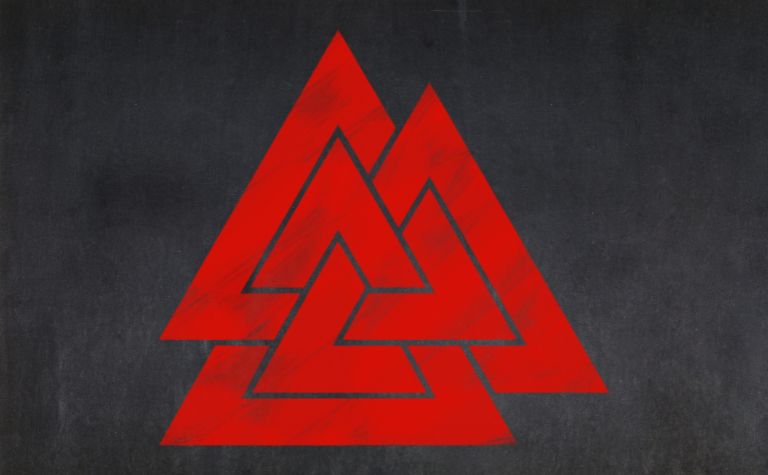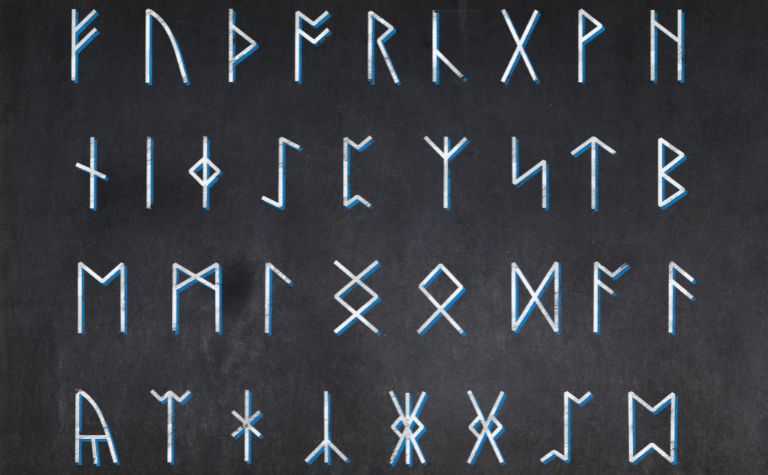With gods like Odin and Thor becoming more mainstream and shows like Vikings: Valhalla topping the charts, more people than ever are getting Norse-inspired tattoos.
However, many neo-Nazi and white supremacist groups have co-opted Norse tattoos for their own uses. [1]
Unfortunately, that means some Norse tattoos are best avoided.
Here are the seven Norse tattoos to avoid:
- The Triskelion
- The Valknut
- The Othala/Odal Rune
- The Tyr Rune
- The Sig Rune
- Odin’s Ravens
- The Sonnenrad (Black Sun/Sunwheel)
This article will explore all seven of these symbols in greater detail. It will outline their history and original meanings.
It will also discuss the current, less Norse-related meanings they’ve taken on and why most people shouldn’t get them tattooed today.
Also, see What Does the Valknut Symbol Mean? to learn more.

1. The Triskelion
The Norse Triskelion (also called the Celtic Triskele) is a simple figure comprising three interlocking horns.
There are numerous variations of it; some feature straight lines, while others incorporate curves.
The Norse version is straighter and represents three interlocking drinking (mead) horns.
Specifically, it represents the horns of Óðrœrir, Boðn, and Són. Triskelions are the marks of storytellers, poets, musicians, historians, and skalds. [2]
They also represent the power of three and the beauty of symmetry. The number three has always been an important number in Norse beliefs, and the Triskelion isn’t the only symbol that showcases a triple representation.
However, today, people avoid this beautiful tattoo because far-right extremist groups frequently use it to identify themselves as white supremacists.
They first used a version of it in 1973. Instead of three interlocking horns, it was three strategically arranged 7’s.
Still, today, most versions of the Triskelion relate to Nazi culture.
Also, see What Is the Meaning of Odin’s Horn? to learn more.
2. The Valknut
The Valknut is another figure that incorporates three interlocking symbols. Instead of horns, though, it uses triangles. Initially, the symbol was used as a powerful mark representing Odin.
When historians unearthed tombs with Valknuts engraved on them, they reasoned that the tombs held great warriors, those slain in battle.
The word Valknut literally means “knot of the slain warrior.” It was the sign of a good death, a death that was pleasing to Odin. [3]
It is another symbol that the Nazis and the Third Reich co-opted. Today, white supremacists and neo-Nazi groups still use it to show their dedication to white power and their various organizations.
The symbol still means that people are willing to sacrifice their lives for a cause; unfortunately, the cause is rarely noble.
3. The Othala/Odal Rune
Originally part of the Nordic runic alphabet, the Othala or Odal rune was representative of the letter ‘O.’
It had a relatively benign meaning (heritage, inheritance, or inherited estate) until the Nazis incorporated it into their propaganda during WWII. [4]
Today, people often find the rune in logos, flags, or banners for hate groups. It represents the Aryan nation and those who believe that white people are some sort of master race.

4. The Tyr Rune
The Tyr rune, sometimes called the Tiwaz rune, was the runic representation of the one-armed Norse god Tyr. He was a great warrior and a symbol of justice and law.
Those who were like Tyr were fair and even-tempered. They could fight well, but fighting wasn’t usually their first course of action.
Like most of the other symbols on this list, though, the Nazis stole the Tyr rune and turned it into something ugly.
Unfortunately, today, this simple design is one “of the most common white supremacist appropriations of ancient runic symbols.” [5]
5. The Sig Rune
Today, the Schutzstaffel is probably one of the most well-known symbols representing Nazi Germany during WWII.
Perhaps the only symbol people more readily recognize is the swastika. However, almost everyone is familiar with the double lightning bolts or ‘SS’ symbol of the Nazis.
Originally, though, the lightning bolt or ‘S’-shaped rune was simply the Sig rune. It represented victory in battle, which is likely what made it such a popular choice for the Nazi regime.
Today, anyone seen sporting the Sig rune, especially if they have two of them side by side, is instantly recognizable as a neo-Nazi supporter.
6. Odin’s Ravens
In Norse mythology, Odin’s ravens Huginn and Muninn represent thought and memory. It seems like something so innocuous shouldn’t present much of a problem today.
After all, having a raven tattooed on one’s arm could mean anything! Maybe the wearer simply likes birds or is an Edgar Allan Poe fan.
Perhaps unsurprisingly at this point, the ravens also represent the Soldiers of Odin or Ravens of Odin.
These are far-right extremist groups who believe in the Aryan master race and that all other people are inferior.
Indeed, this tattoo may be more ambiguous than others on the list. People may not automatically assume someone with raven tattoos is a white supremacist or racist.
However, for those ‘in the know,’ such a tattoo would definitely be a red flag. These tattoos are even logged in a database of ‘gang’ tattoos that law enforcement uses to recognize members of motorcycle gangs when they come in contact with them. [6]

7. The Sonnenrad (Black Sun/Sunwheel)
This Norse symbol has many names. Some call it the Sonnenrad. Others refer to it as the Black Sun or the Norse Sunwheel.
Whatever the title, the design is relatively similar – a circle filled with jagged sun rays branching out from a smaller inner circle.
It was one of Scandinavia’s most prominent symbols. Initially, it represented many good things, including:
- Life
- Goodness
- Unity
- Triumph
- Centering oneself
- Balance
However, the Nazis used it as well, often putting a swastika in its center. Today, far-right groups, neo-Nazis, and white supremacists use the symbol to represent the Aryan race. [7]
Scandinavians and practitioners of Asatru still use the Sonnenrad to symbolize its more wholesome attributes. However, in the U.S., people with this tattoo are often members of one of these extremist groups.
Final Thoughts
As beautiful as many Norse symbols are, most people avoid them as tattoos because of their modern-day links to racist organizations.
References:
[1] Source
[2] Source
[3] Source
[4] Source
[5] Source
[6] Source
[7] Source
